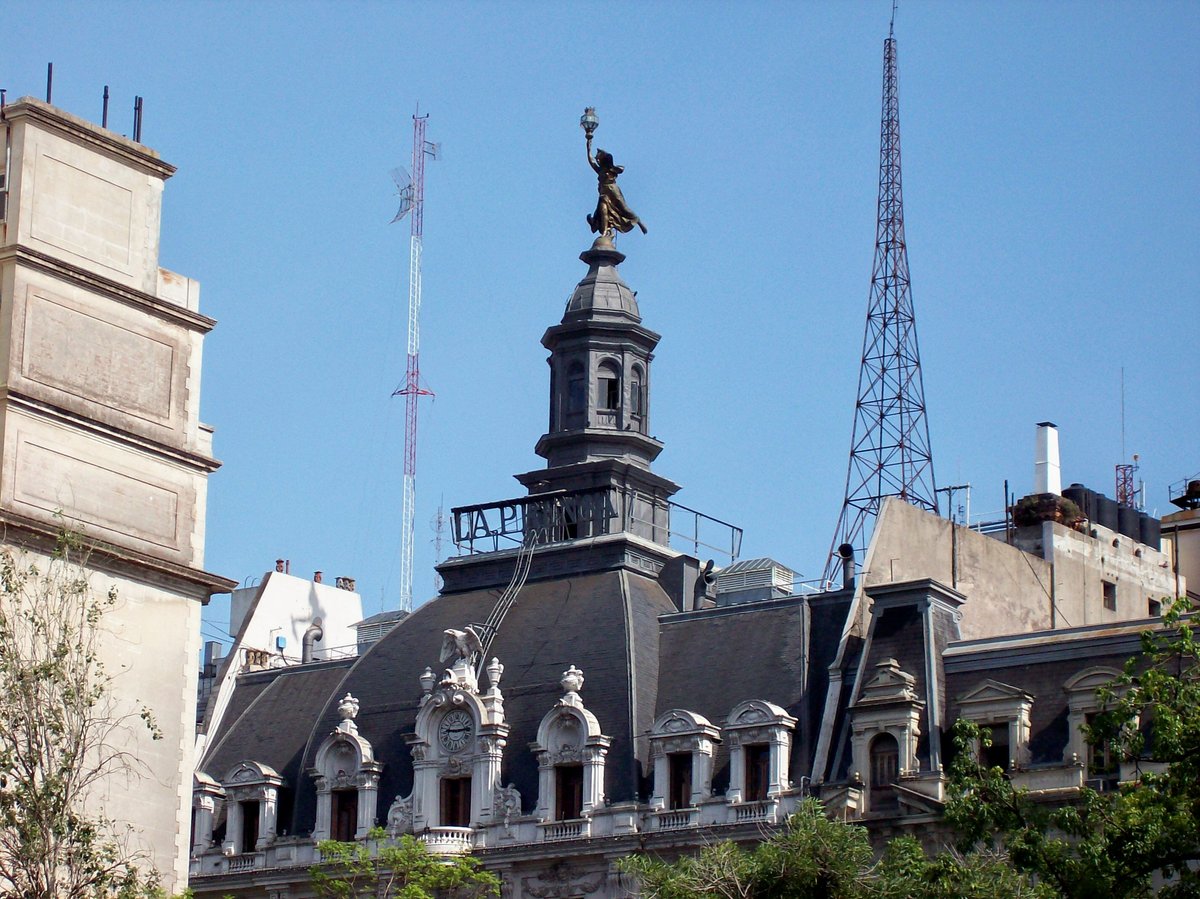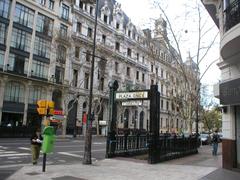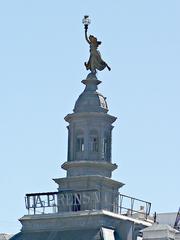
House of Culture Buenos Aires: Visiting Hours, Tickets, and Attractions Guide
Date: 14/06/2025
Introduction
The Casa de la Cultura Buenos Aires, or House of Culture, is a celebrated emblem of Argentina’s rich cultural, architectural, and journalistic heritage. Located on Avenida de Mayo in the historic Monserrat neighborhood, this iconic building was constructed in 1898 as the headquarters of La Prensa, one of Latin America’s most influential newspapers. Designed by Carlos Agote and Alberto Gainza, the building is a striking example of Beaux-Arts architecture, replete with French limestone, Italian marble, and crowned by the bronze statue of Pallas Athena—symbolizing wisdom and freedom of the press. Its prominence in the city’s urban landscape reflects Buenos Aires’ ambitions during its golden age to be the “Paris of South America,” a vision fueled by European immigration and economic prosperity (BBC Travel; Wikipedia).
Beyond its architectural grandeur, the Casa de la Cultura has played a pivotal role in Buenos Aires’ cultural and civic life. Home to the renowned Salón Dorado, the building has hosted concerts, lectures, and major public events, attracting intellectuals, politicians, and artists. Its story mirrors Argentina’s political turbulence, especially during the Perón era, when it was expropriated and repurposed for labor union activities before being restored and transformed into a public cultural center in 1988. Today, the House of Culture stands as a dynamic venue for exhibitions, performances, and civic engagement, celebrating the city’s multicultural heritage and ongoing creative innovation (The Collector; Turismo Buenos Aires).
This comprehensive guide provides essential information on visiting hours, tickets, accessibility, guided tours, and tips for exploring nearby historic landmarks, ensuring a rich and informed experience at one of Buenos Aires’ most treasured sites (globetrottergirls.com; britannica.com).
Table of Contents
- Introduction
- Origins and Architectural Context
- The Golden Age of Journalism and Civic Life
- Political Upheaval and Nationalization
- Transition to the House of Culture
- Heritage Status and Preservation
- Visiting Information: Hours, Tickets, and Tips
- Cultural Impact and Legacy
- Frequently Asked Questions (FAQ)
- Conclusion and Summary
- References
Origins and Architectural Context
The Casa de la Cultura was conceived during Buenos Aires’ transformation into a cosmopolitan metropolis at the end of the 19th century. Built for La Prensa, the building exemplifies Beaux-Arts architecture. Its façade features ornate ironwork, grand columns, and a distinctive dome topped by Pallas Athena. The design reflects the city’s desire to rival European capitals, integrating Baroque, Art Nouveau, and Beaux-Arts influences (BBC Travel).
The architects, Carlos Agote and Alberto Gainza, drew inspiration from the Palais Garnier in Paris. The building’s use of imported French limestone and Italian marble, along with its vertical emphasis and decorative reliefs, exemplifies the commitment to quality and authenticity. Not just an office, it also housed apartments, medical offices, and a concert hall, symbolizing the multifaceted role of media in the city (Turismo Buenos Aires; Wikipedia).
The Golden Age of Journalism and Civic Life
La Prensa was a beacon of journalism, and its headquarters became a nexus of cultural and intellectual activity. The Salón Dorado (Golden Hall) hosted concerts, lectures, and public events, drawing artists, politicians, and thinkers. This era coincided with the city’s rapid modernization and the flourishing of a vibrant café culture, fostering creativity and public debate (The Collector).
The building’s design—with its editorial offices, residential spaces, and public venues—mirrored Buenos Aires’ dynamic social fabric. It was both a symbol of prestige and a practical response to the city’s growth.
Political Upheaval and Nationalization
During Juan Domingo Perón’s presidency in 1951, La Prensa was expropriated amid political tensions and handed over to the General Confederation of Labor (CGT). This transition curtailed its journalistic role and repurposed the building for union activities. Although much of its architectural integrity was preserved, its function shifted significantly, reflecting Argentina’s broader socio-political changes (BBC Travel).
Transition to the House of Culture
With Argentina’s return to democracy, the building was designated as the Casa de la Cultura in 1988. Restoration efforts preserved original features like marble staircases, stained glass windows, and gilded moldings. Former offices now serve as exhibition spaces, galleries, and event halls, showcasing both the building’s grandeur and contemporary Argentine culture (Turismo Buenos Aires).
Heritage Status and Preservation
The House of Culture’s restoration aligns with Buenos Aires’ broader efforts to protect its diverse architectural heritage. The 2008 Law of Heritage Protection and advocacy from groups like Basta de Demoler have strengthened safeguards for historic buildings (BBC Travel). Official designation as a protected heritage site ensures ongoing maintenance and public access, making the Casa de la Cultura a model for adaptive reuse and conservation.
Visiting Information: Hours, Tickets, and Tips
Visiting Hours
- Standard Opening: Tuesday to Sunday, 10:00 AM to 6:00 PM (sometimes until 7:00 PM for special events).
- Closed: Mondays and public holidays.
- Always confirm exact hours on the official tourism website.
Tickets and Admission
- General Admission: Free for most exhibitions and public events.
- Special Events: Some concerts, workshops, or temporary exhibitions may require a ticket or advance registration.
- Booking: Tickets can be reserved online or at the entrance.
Guided Tours
- Languages: Spanish and, frequently, English.
- Schedule: Typically daily at 11:00 AM and 3:00 PM; advance booking is recommended, especially for groups.
Accessibility
- Facilities: Ramps, elevators, and accessible restrooms. Some historic areas may be less accessible, so contact the venue ahead for specific needs.
Special Events and Photography
- Events: Year-round programming includes concerts, exhibitions, and workshops.
- Photography: Permitted in most areas for personal use. Restrictions may apply during special events or for professional shoots.
Nearby Attractions
Within walking distance are several must-see sites:
- Plaza de Mayo
- Palacio Barolo
- Café Tortoni
- Teatro Colón
- Metropolitan Cathedral
(The Collector; globetrottergirls.com)
Cultural Impact and Legacy
The Casa de la Cultura is more than a preserved building—it is a living symbol of Buenos Aires’ resilience, creativity, and civic engagement. From its origins as a newspaper headquarters to its transformation into a cultural center, it has continually adapted to the city’s evolving identity. Its ongoing use and careful preservation underscore the importance of adaptive reuse in urban heritage, and its halls echo with the voices that have shaped Argentine history (lacgeo.com; Britannica).
Frequently Asked Questions (FAQ)
Q: What are the visiting hours for the House of Culture Buenos Aires?
A: Generally Tuesday to Sunday, 10:00 AM to 6:00 PM (or 7:00 PM for events). Closed Mondays and holidays.
Q: Is there an entry fee?
A: General admission is free. Special events or exhibitions may require tickets.
Q: Are guided tours available?
A: Yes, in Spanish and often in English. Booking in advance is recommended.
Q: Is the building accessible for people with disabilities?
A: The building has ramps and elevators, though some historic areas may have limited access.
Q: Can I take photographs inside?
A: Photography for personal use is permitted in most public areas. Restrictions may apply for events or professional shoots.
Q: How do I get there?
A: Centrally located on Avenida de Mayo, the House of Culture is accessible by subway (Line A, Peru station; Line C, Avenida de Mayo station), bus, bike, or on foot.
Conclusion and Summary
The Casa de la Cultura Buenos Aires remains a vibrant testament to the city’s rich history and ongoing commitment to the arts, civic life, and multicultural celebration. Its architectural splendor, storied past, and dynamic programming make it an essential destination for anyone seeking to understand and experience the cultural heart of Buenos Aires. Visitors are encouraged to plan ahead, confirm details on official platforms, and embrace the full spectrum of experiences available, from guided tours to contemporary exhibitions and performances. For the latest updates, ticketing, and event schedules, always refer to the official Casa de la Cultura website.
References
- Preserving History in Buenos Aires, BBC Travel
- Buenos Aires House of Culture, Wikipedia
- Secrets of Buenos Aires’ Historic Quarter, Turismo Buenos Aires
- History Lover’s Guide to Buenos Aires, The Collector
- The Palace: The House of Culture, Welcomeargentina
- Cultural Landscape Argentina, lacgeo.com
- Buenos Aires Arts and Culture, Britannica
- Guide to Buenos Aires Argentina, Globetrotter Girls
- The Legacy of Indigenous Guarani Culture in Buenos Aires, Vamospanish































































































































































